~ 6 ~
~ The Study of Threes ~
http://threesology.org
Researchers as of 8/29/2019
| Devil's Advocate Series: | ||||||||
|---|---|---|---|---|---|---|---|---|
| 1 | 2 | 3 | 4 | 5 | 6 | 7 | 8 | 9 |
| 10 | 11 | 12 | 13 | 14A 14B |
15 | 16 | 17 | 18 |
| 19 | 20 | 21 | 22A 22B |
23 | 24 | 25 | 26 | 27 |
| 28 | 29 | 30 A | 30 B | 31 | 32 | 33a | 33b | 33c |
| 34 | 35 | 36 | 37 | 38 | 39 | 40 | 41 A | 41 B |
In speaking about photosynthesis, the word "photo" may bring to mind the variations that not only occur at different periods of the day but also at night, such as the brightness of a full moon. In addition, when discussing the color of the world as it may have been billions of years ago due to different compositions of dominant materials during different time periods, the color spectrum can be used as a scale of measurement with respect to the differing intensities by which plant-based photosynthesis occurs. In a more direct reference to what I'm getting at, is that the position of the Sun on its daily path exercises more and less poignant exertions on plants, thereby creating a pattern which can be plotted on a numerical graph. For example, we can say that the most intense "moment" of the Sun's irradiation is the value "1", while lesser gradations are assigned number values following this symbol. And even if we were to uncover a scale of numbers exceeding the color spectrum quantity proposed by Newton, the fact remains that we are using a small number value that we can either argue is inherent with the material being studied, or come to question why small number values are being used in different subject matter, and thus entertain the idea that such a recurrence is suggestive of an imposed constraint on human thinking... perhaps due to an environmental circumstance that I am at present considering to be related to the incremental deterioration of the planet which is forcing all of life to adopt a small-number orientation as a pseudo-survival mechanism... I say "pseudo" because it is a survival mechanism leading humanity over the cliff of extinction... like a herd mentality that socially rationalizes the usage thereof and makes laws to demand its usage. Like Newton, we are being forced into adopting predispositions of cognitive orientation. (Newton originally divided the spectrum into six named colors: red, orange, yellow, green, blue, and violet, but then added indigo because of his philosophical disposition towards thinking the quantity of "seven" was somehow representative of a perfect number as derived from the ancient Greek sophists, of there being a connection between the colors, the musical notes, the known objects in the solar system, and the days of the week.)
However let me note that I consider the presence of multiple spectrums of development occurring concurrently or even simultaneously such as in the case of pre- and post-biological development and the succeeding and interrelated development of the simple to complex life forms such as humanity. Examples are the presence of the triplet code in simple and complex life forms as well as the three germ layers in their various monoploblastic, Diploblastic, triploblastic ensembles. Each developmental process whether or not a full "three" is achieved as yet in the history of the planet, is a spectrum unto its own and alongside one or more others that may be occurring. Let me provide a preliminary introduction of such a timeline as is presently being conceived. Clearly the old singular linear model of geologically-matched biological development is particularly simplistic for more detailed representations many researchers are striving to conceptualize in their own research interests. Eventually I will add the overlapping variables of the expanding Universe, rotation rates of the Earth, oxygenation of the atmosphere, etc...:
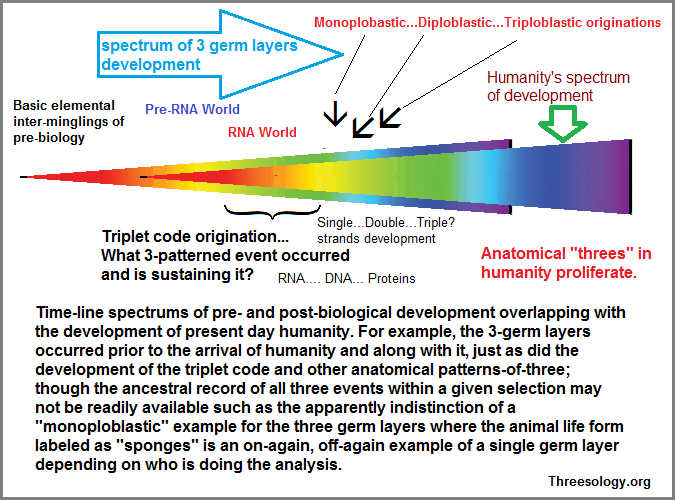
Developing a time-line referencing "threes" examples necessarily entails referencing those patterns which lead up to a three and those which do not, as well as for example those patterns which do not appear to represent an explicit "three" but can be in someway's interpreted as such. For example the five fingers and five toes with two digits on the thumb and three digits for the fingers, and the spreading out thereof as an "aborted?" radial plan, where the "radial" is alternatively described as circular aligned with the linear-circular-triangular geometric profile. Whereas the "5" is a recurrence, this recurrence may not suggest a dominant currency of activity like that of the "1" and "2" and "3" patterns. Then again perhaps it does but has been overlooked like the recurrence of so many (small numbered) patterns. Time will tell as we pursue greater detail for the development of the timeline in the decades ahead.
For a moment, let's take a look at the Pentadactyl limb since some readers may think that it represents a wrench thrown into the works of a "Threesological" perspective. Here is an example of the idea:
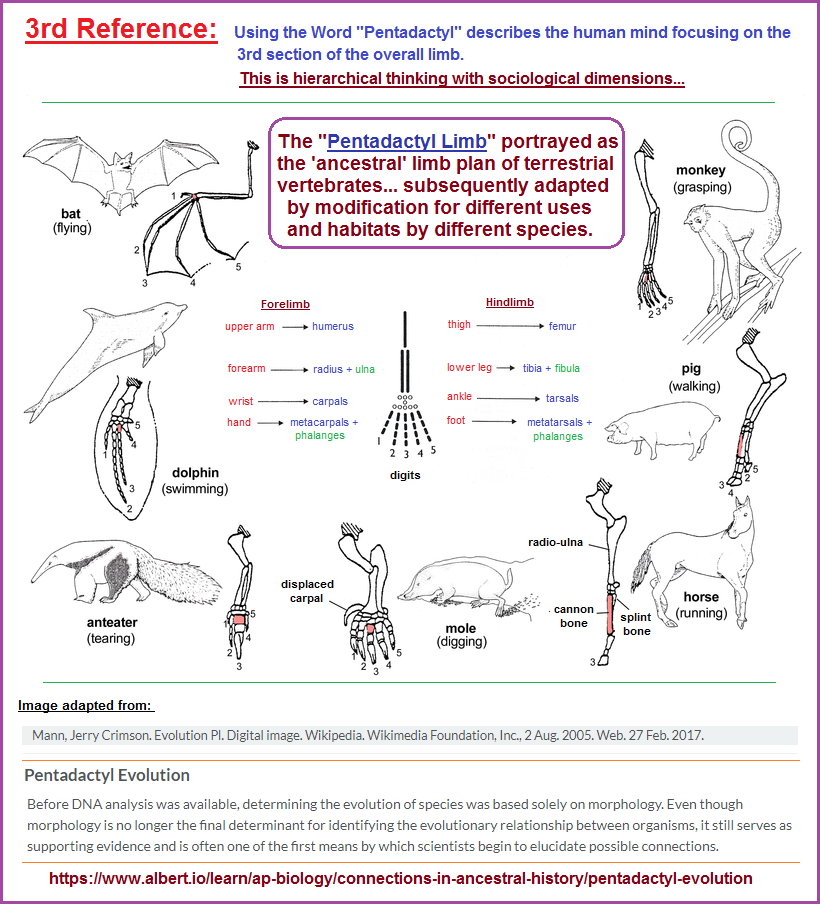
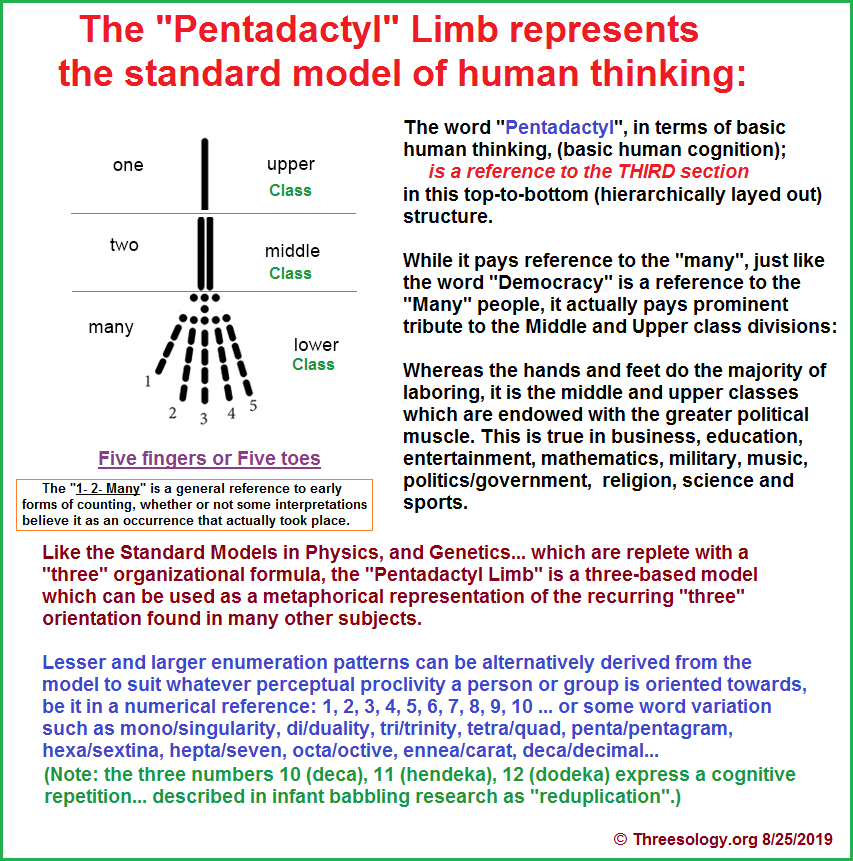
First off, the word "Pentadactyl" illustrates the human mind focusing on the 3rd section of the overall limb, in that we either divide the limb into a hierarchically arrayed "one-bone, two-bone, many-bone" assignment, or an "upper-middle-lower" designation which has a Sociologically applicable dimension which can be explored further, and I may do so later on in the discussion. For now, it is of value to point it out:
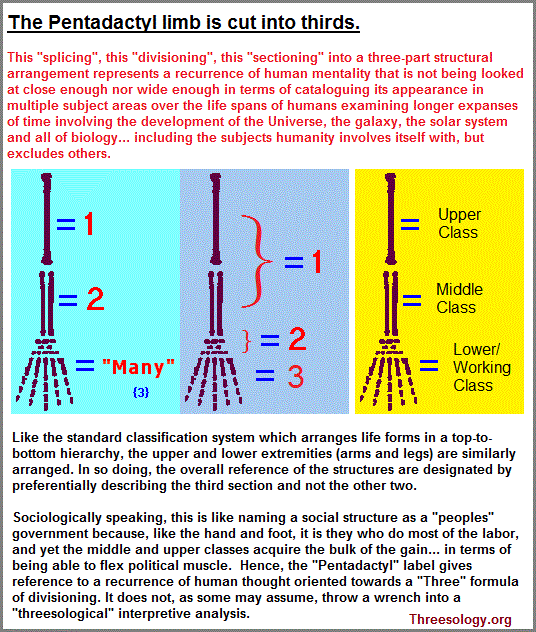
Interestingly, while there is a usage of the terms "Homologous" (similar structure) and "Analogous" (similar function), there is not distinct referencing of a quantitative comparison, though it is used and implied by the two terms. The inclination or 'deferment' of the human mind using two... and only two as major comparative themes of reference suggests a cognitive stopping point has been effected, similar to that found in the stopping points of primitives in history in their development of quantitative number usage. The "One- Two- Many" words for number quantities is an example of using three number words... each assumed to have had their own stages of development with stop gaps before the next quantitative value became adopted by different language communities with a developing commerce involving collecting/hoarding, selling and buying.
We do not make usage of a distinct reference where a quantitative measurement is part of the formulation though an analysis may well contain such a usage. Thus, such a usage would seem to require a definitive reference of its own.
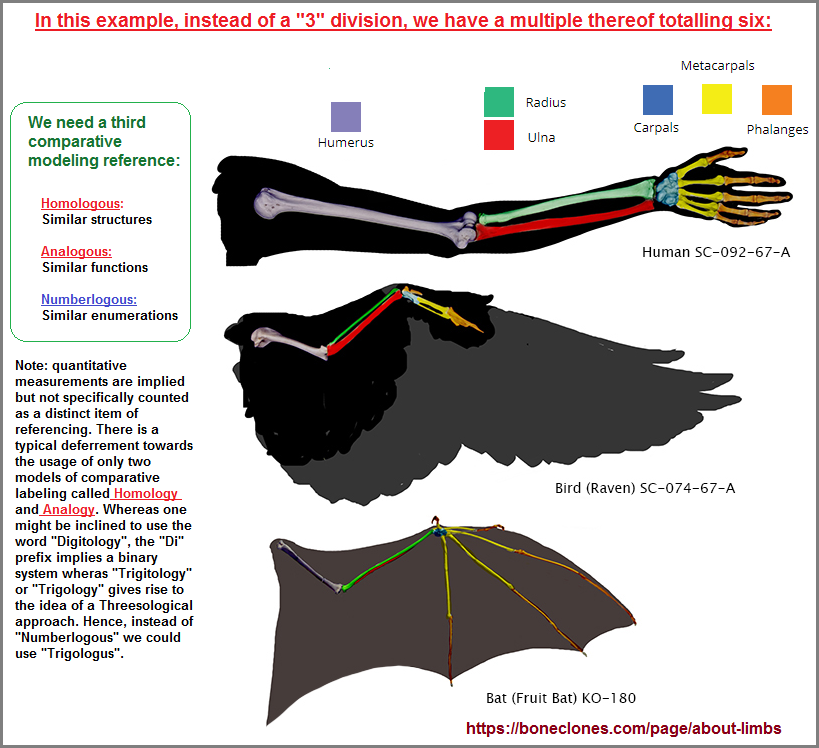
Let us look at some "three"-based types of locomotion since we are on the subject of limbs:

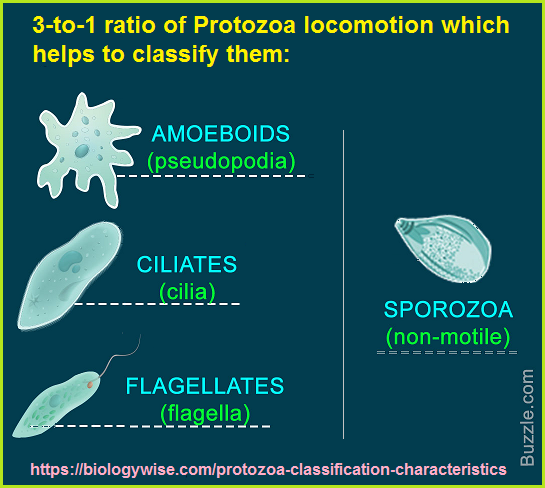
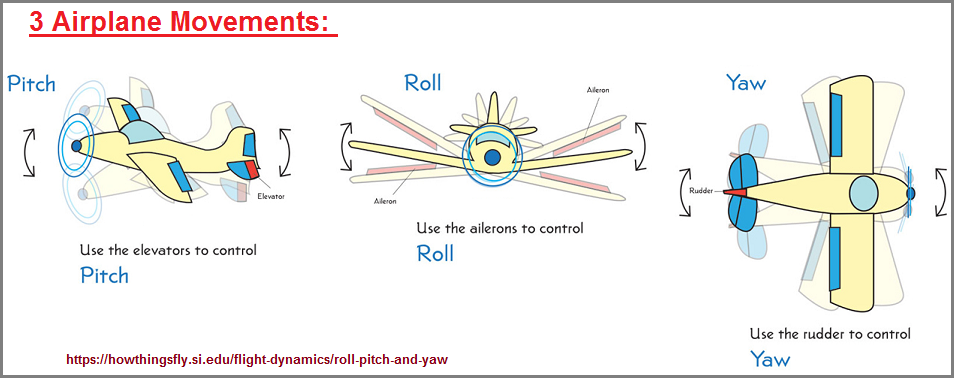
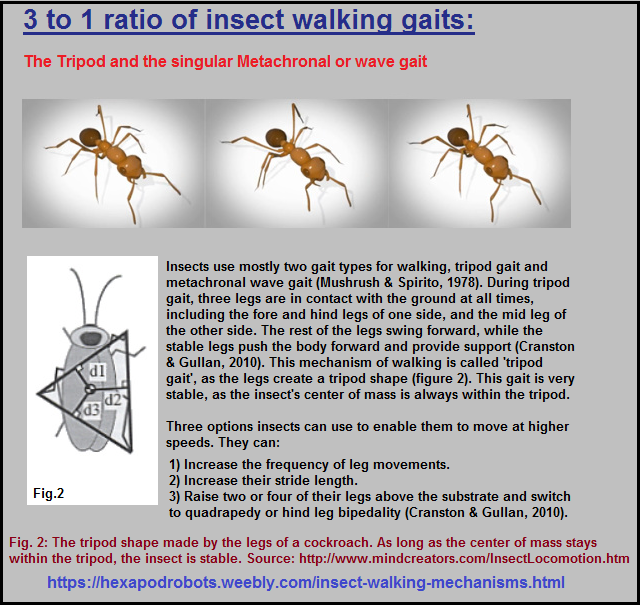
However, let us not discount attempts by biology to have an inherent inclination to be individually expressive as might be denoted by the word "creativity", though most biological expressions are conformist viewed as being constrained... like one's attempt to build a shower whose dimensions are outside conventional manufactures designs, requiring one to look for someone who can create a non-typical design according to one's own plans... and yet even these so-called liberal makers engage in conformities (i.e. business tactics supported by legalities developed by (status-quo mediocrity) dubbed safety rules/guidelines/procedures (S.tandard O.perating P.rocedure) which do not themselves go out of their way to encourage nor permit creative dimensions exceeding the rules which are meant to perpetuate both the rules and rule makers)— so as to increase the amount of money (and manipulative control) they can get off a single person (or group) such as when a manufacturer refusing to build a shower stall to a customer's expectations without also being able to install it... or insisting upon taking measurements in a customer's home, whereby the cost of the shower and labor will be determined by the quality of the neighborhood in which the person lives (middle class, upper class, etc.), lavishness of home furnishings, employment of the customer, type of vehicle in the driveway, presumed cost of house, cost of apparel, etc...
It is the same old song and dance where a person or group is forced to conform or pay dearly for their non-conformity... and yet, perhaps in some cases what is worse, is that the non-conformity (like the LGBTQ or some other social diseases), move to position itself into a pandemic situation by insinuating and integrating and otherwise weaseling itself through the three models of symbiotic relationships: mutualism, Commensalism, and/or parasitism under the facade of an "extenuating normalcy" dubbed with the moniker of "creativity" or whichever politically viable term is most amenable in a given time and place; but nonetheless creates a distortion of the basic conformist plan which... because it appears to be linked to an environmentally directed course of incremental deterioration, must try to eventually regain the footing of that particular type of "following-in-the-footsteps" formula of equilibrium, unless its presumed creativity is thus directed towards the development of a species that is enabled to remove itself from its Earthly constraints that are being projected into the recurring patterns that I am trying to draw out in the time-line being developed.
If a person objects to the idea of less, some, and more currencies represented in numerical, geometric and other patterns represented by the focus of attention on the 1,2,3 lineage because they are focused on exceptions such as 4,5,6,7,8, or otherwise, then we are obliged to contain them in the timeline and note whether they are a standard re-currency, or are they an exception to the currency such as the occasional presence of a two-dollar bill being used?
As a result of banking policies with businesses which have resulted in low production numbers due to lack of demand, two-dollar bills do not circulate as well as other denominations of U.S. currency. This comparative scarcity in circulation, coupled with a lack of public knowledge that the bill is still in production and circulation, has also inspired urban legends about its authenticity and value and has occasionally created problems for those trying to use the bill to make purchases. The apparent scarcity of the $2 bill, in spite of its production figures, also means that large numbers of the bills are taken out of circulation and collected by people, who may believe the bill to be rarer than it actually is.
United States two-dollar bill
Alternative references: United States Dollar; Slang terms for money; Promotional United States fake currency
Analogous to the topic of biology, in the American denominations of money we find a mere 18 varsities of three different species, with the third species as a reference to those on the verge of extinction, though they are sought after by collectors:
Species 1 = Metal Coins (still being minted)
- one-cent coin (penny)
- five-cent coin (nickel)
- ten-cent coin (dime)
- 25-cent coin (quarter)
- 50-cent coin (fifty-cent piece/ half-a-dollar)
- 100-cent coin (dollar piece)
Species 2 = Paper/Rag bills (still being printed)
- 1-dollar bill
- 2-dollar bill
- 5-dollar bill
- 10-dollar bill
- 20-dollar bill
- 50-dollar bill
- 100-dollar bill
Species 3 = Old Paper/Rag bills (no longer being printed but still considered viable tender... thus, they are still "alive".)
- 500-dollar bill
- 1,000-dollar bill
- 5,000-dollar bill
- 10,000-dollar bill
- 100,000-dollar bill
Source: US Dollar Symbols and Denominations
With respect to patterns, the word "pattern" is frequently substituted such as in the case of distinguishing body plans with the word "symmetry" as the collating objective, of which there typically are three that become identified (1. Spherical, 2. Radial, 3. Bilateral), but with the addition of the notion noted as "asymmetry", we have a 3-to-1 variation of assignment. The development of these body plans as a collective spectrum of development will have to be placed onto our time-line. In some variations of this body-plan formula based on symmetry, the "Spherical" selection is lumped together with "radial" and there is the remaining three types of Asymmetry, Radial, and Bi-lateral.
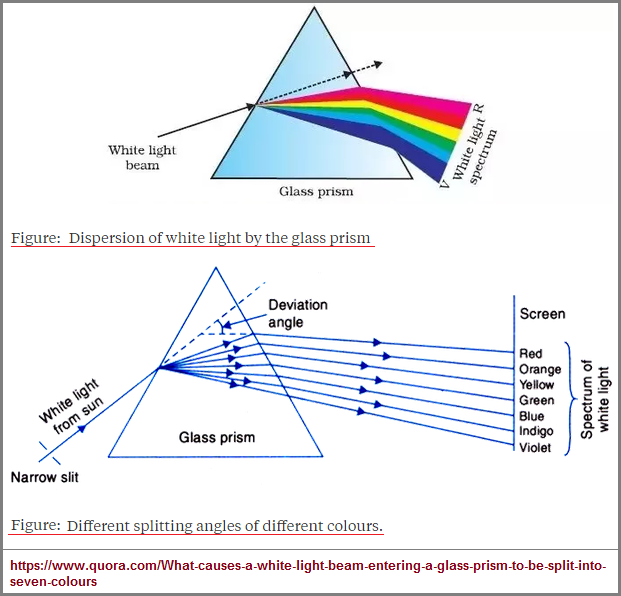
The point to be made with a question is whether photosynthesis is "felt" by plants in a three-patterned way? While the different colors affect the rate of photosynthesis, are there three colors which are most dominant? How much of the EM spectrum affects (or effects) photosynthesis besides the visible? (I am neither inclined to accept everything I read nor unafraid to re-question old ideas from a different perspective... even if the same questions appear to have been already asked and answered to the satisfaction of others.)
Sources listed:
|
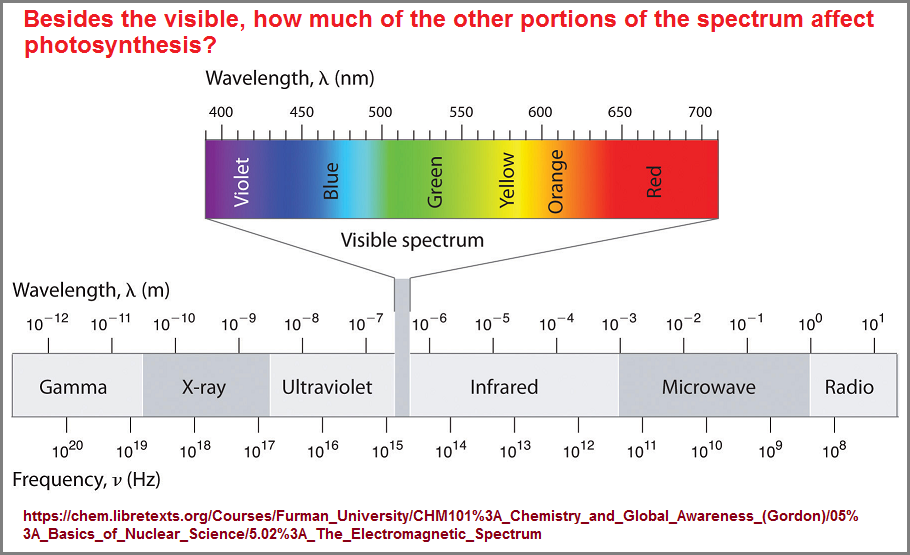
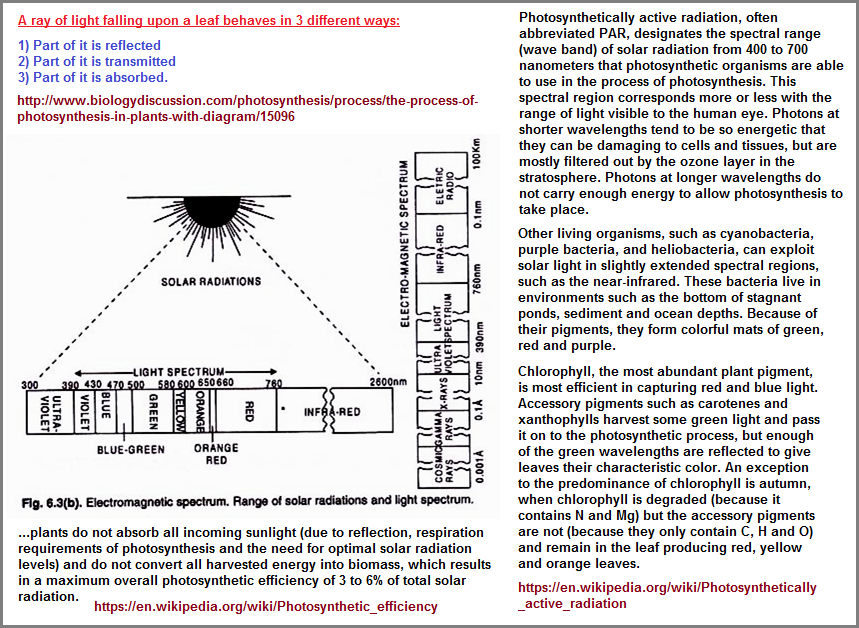
Witness the influence of the sun on the seasonal abundance of plant matter produced on land and in our oceans.
Timelapse: Photosynthesis seen from space
Origination date: Tuesday, June 25, 2019... 4:41 AM
Initial Posting: Saturday, September 1st, 2019... 7:43 AM
Updated Posting: Tuesday, January 17th, 2023... 11:53 AM
Herb O. Buckland
herbobuckland@hotmail.com